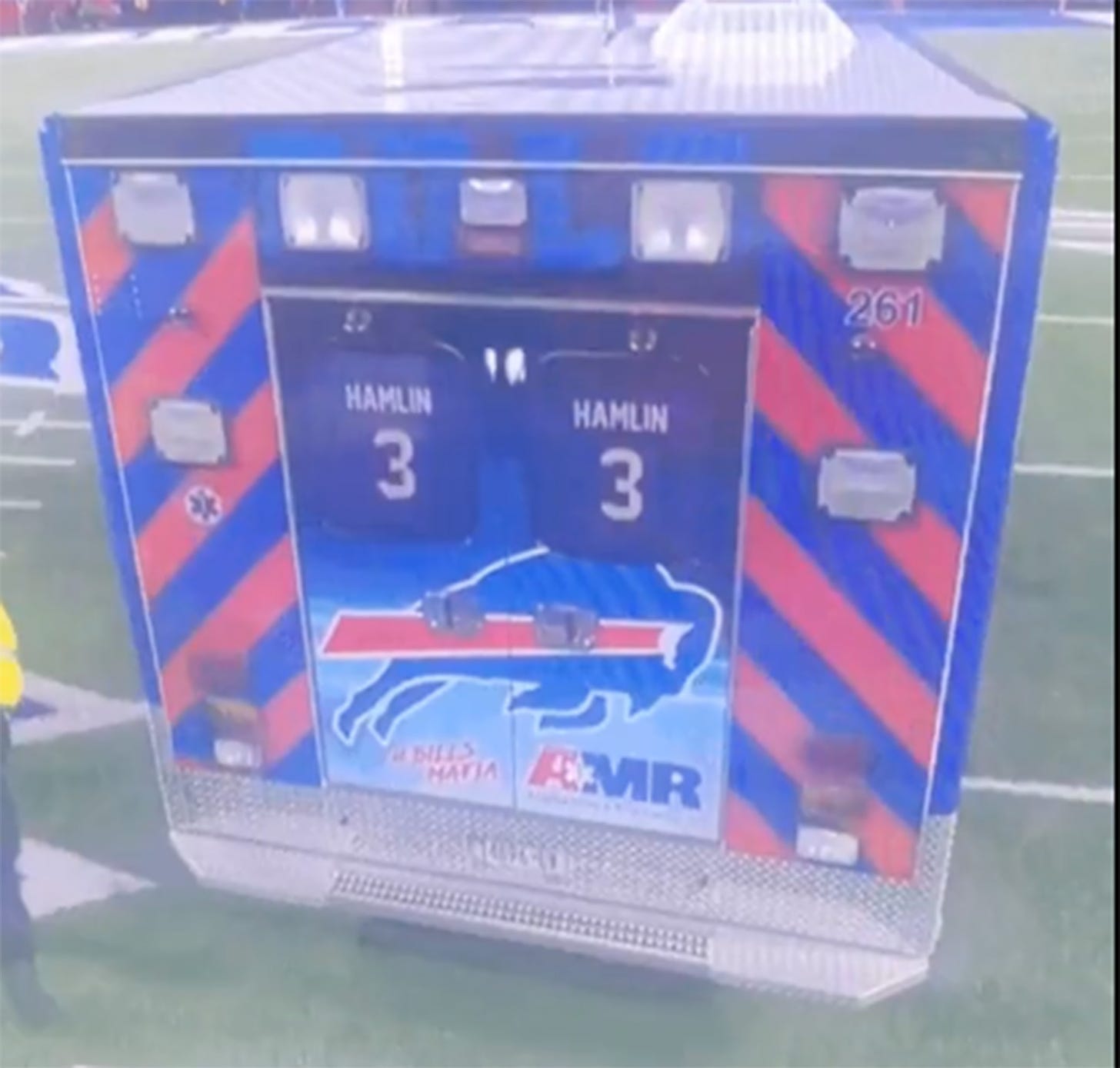It’s gonna be a busy end of year but I hope everyone is having exactly the kind of Thanksgiving they need in 2023. As someone who moved every couple years growing up, the one thing I have always been envious of this time of year is the Wednesday-night-before-Thanksgiving hang for people who grew up in one place. I figure the shine of seeing your high school friends and asking them how the corporate finance gig at the paperclip factory before ordering one million Bud heavies and repeating the process probably dulls after the first few years of doing it, but I also imagine there are some fun, Hallmark-ass moments as well.
Hut 🏈 hut 🏈 hut 🏈 hut 🏈 hut 🏈
(If you don’t know the reference above please watch this weird ass mid-2000s video and scrub to 1:30.)
For the third time in a calendar year, I saw a candy striped red-and-blue ambulance roll onto the turf at Highmark Stadium in Buffalo to rush a player to a local hospital with a traumatic injury. The collision between Bills LB Taylor Rapp and Jets RB Breece Hall looked pretty innocuous in real-time. Rapp even got credited for an assisted tackle on the play as he stopped Hall’s momentum while the running back was going down. But when you slow down the replay, you can see Rapp’s skull retract into his pads and snap back out from the impact of Hall’s shoulders. The movement is so fast he looks like a spring loaded turtle.
Human spines aren’t supposed to do that. Rapp stood up for a minute before collapsing and being surrounded by his teammates who desperately gestured for help. Players seem to intuit the difference between a hit and an injury much faster than anyone else, partially due to proximity and partially due to their own hyperawareness of the violence of their own sport. The ambulance slowly drove onto the field a minute later, its back windows painted with the name of another Bills' player who collapsed on the field back in January: Damar Hamlin.
Hamlin’s injury was as freakish as they come. He was hit directly in the chest by the crown of an opposing player’s helmet in the ~20 milliseconds that your heart is resting between beats. The impact caused an arrhythmia and put him into cardiac arrest. It was awful to watch in real-time: many players kneeling in prayer, some silently crying in worry.
What’s interesting is that no one knew that it was Hamlin’s heart that had given out at the time. We all—and I use “we” to include both the frothing masses of football fans and an educated guess as to the opinions of ex-players and commentators—assumed that Hamlin has undergone some sort of traumatic spinal or cranial injury. That we were so quick to come to that very specific set of common conclusions signals that we’re all just waiting for “it” to happen, that football is always teetering on the edge of a snuff film. It’s an interesting collective anxiety to hold. I’ve been in bars that have gone silent or groaned in harmony after a big hit. We all know it’s coming, we just don’t know when.
I’m close with several Bills fans (shout out to the new dads Cam Curran and Thomas Murray) and they were shaken by the Hamlin injury to say the least. But we were all similarly shaken last month when Bills RB Damien Harris lay motionless on the field, the familiar, cheery ambulance rolling toward him while the whole stadium went deathly quiet. The most heartbreaking is watching how players react. Their eyes don’t focus anywhere but on the motionless player.
Watching football as a fan presents this parasocial relationship that has been finely tuned to give us an emotional attachment to a team made up of professional strangers. But, of course, those guys are not strangers to each other. As much as we like to say that pro sports are a “job,” the physicality and competitiveness of the industry makes the bonds between teammates a little different than, say, your marketing department. They also have their own collective anxieties. What happened to Hamlin, Harris, and Rapp could happen to any of them, just as they know the doomsday clock of CTE slowly counts down over their heads.
“We play a violent game,” ex-player Booger McFarland said from the ESPN studios after the Hamlin injury. The entire crew of analysts, usually so at ease finding platitudes or anodyne critiques of what was happening on the field, seemed genuinely shocked at what they were seeing. McFarland had played almost a decade in the league; on-field hits paralyzed players in the year before he entered the league and the year after he retired. He is an unusually honest character at the analysts’ table, an avatar for the guy who just loves football. McFarland’s silent shake of the head stood in for all of us, unsure of what to say or where to look.
The rest of the broadcast team as well as the league at-large was scrambling to figure out how to make sure the composite guilt and shame we felt wasn’t permanent. Hamlin having a heart attack was actually a good thing for the league. An aberration can’t put any pressure on the system. It’s a freak accident, there wasn’t anything we could do about it! The inquiry could end and Hamlin could do a victory tour after he recovered in the hospital. We could all rest in the comfort of a tragic accident.
This isn’t an argument against football, or meant to draw out disgust or change your viewing habits. I’ll watch football this weekend, and the weekend after that. I don’t even have a team and I’ll watch at the bar! But I am curious about three locations of anxiety here: those of the players, those of the viewers, and the one that exists at the intersection of those two threads. Another, hopefully bigger essay at some point.
Some music
Friend of the letter Josh Terry (who has a wonderful newsletter called No Expectations) put together a no-skips Thanksgiving playlist (Apple Music version here):
Some clothing
I love this sweatshirt so much shout out the amazing newsletter Human Repeller






